 |
|
|
|

Days Four and Five of our Voyage of Discovery were dedicated to collecting the data the students would need to test their hypotheses. Some students started collecting data while the Half Moon was underway from Haverstraw Bay past Yonkers and Manhattan, but most took advantage of our layover in Grave's End Bay.
During the data collection phase, each student team established a work schedule for gathering data, collected and analyzed samples, and recorded their findings. Some student teams also chose to change their research topics due to situational interference (such as a cloudy night preventing Greg and Ross from tracking the moon).
You can scroll down or use the links below to jump directly to a section.
|
|
Comparative Temperatures
|
| 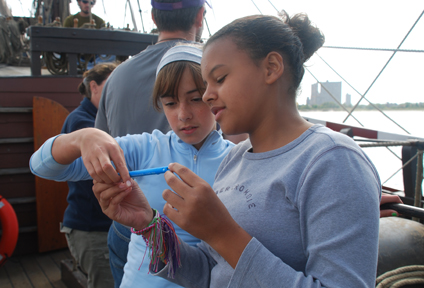
Students: Christina & Evi
Materials: Thermometer, wet thermometer, canvas bucket.
During the Half Moon's voyage downriver, as well as during our data collection layover in Grave's End Bay, Christina and Evi will collect surface water samples with a canvas bucket. One student will then use a wet thermometer to measure the water sample's temperature while her partner simultaneously uses a thermometer hanging from the main mast to check the ambient air temperature. They will then compare these temperature readings and, supplementing their own research with anchor watch data from the Deck Log, will seek to discover whether any correlation exists between them.
|
Back to Top
|
|
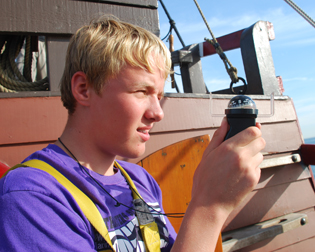 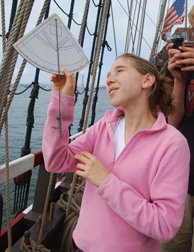
Students: Andrew & Lizzie
Materials: Quadrant & directional compass.
Andrew and Lizzie will use a quadrant to track the altitude of the Sun and a directional compass to determine its azimuth. To determine true local noon, they will record the moment when the Sun reaches its highest altitude. At the moment of true noon, the Sun's azimuth will determine true south.
|
|
Tidal Patterns
|
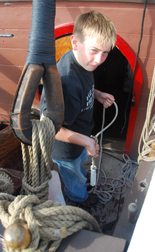 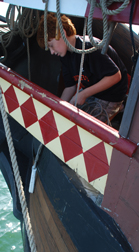
Students: Greg & Ross
Materials: Lead line, tape measure, stopwatch, wooden biscuits.
Greg and Ross initially chose to use celestial tracking to track the Moon's transect across the night sky, but overcast skies during our data layover prompted them to switch to a new topic.
Instead, Greg and Ross will track current speed and use a traditional lead line to sound the water's depth at a fixed location throughout a tidal cycle. Through this technique, they will be able to measure the height of tide as well as determine the times of the ebb, slack, and flood tides.
|
Back to Top
|
Relative Humidity |
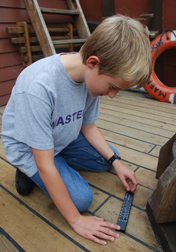 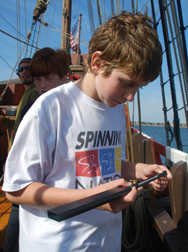
Students: Luke & Peter
Materials: Sling psychrometer, thermometer.
Luke and Peter will use a sling psychrometer to measure relative humidity levels throughout our data layover, supplementing their own research with anchor watch data from the Deck Log to track humidity patterns and air temperature throughout a full 24-hour period.
|
Back to Top
|
Salinity |
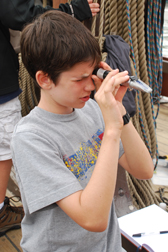 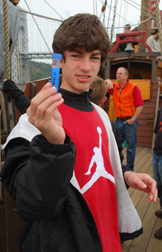
Students: Bennett & Jonathan
Materials: Canvas bucket, sample jars, GPS unit, refractometer.
Bennett and Jonathan will use a refractometer to analyze the salinity levels in the water samples we have collected throughout our voyage downriver. In addition, during the ship's data collection layover in Grave's End Bay, they will collect water samples on the hour, tracking changes in salinity over the course of a tidal cycle.
|
|
Mechanical Advantage
|
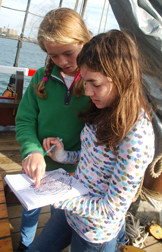 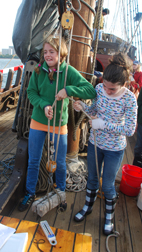
Students: Jena & Natalie
Materials: Spring scale, lead ballast ingot, block & tackle system, Mr. Chase.
Jena and Natalie initially chose to study turbidity for their project, but a morning of reading produced consistently flat readings (which is to be expected in these conditions). While this lack of variation is a scientifically valid result, it's not very dramatic, so the team switched their topic to a study of mechanical advantage.
With the assistance of senior advisors Ms. Reilly and Ms. Smith, Jena and Natalie will construct an adjustable block-and tackle simple machine on the weather deck. They will then rig different combinations of pulleys and leads to see how they affected the force needed to lift a 60-pound lead ballast ingot. With each configuration, they record the force needed to lift the ingot (as measured on the spring scale), with the ultimate goal of determining how much force will be needed in each configuration to lift Mr. Chase off the deck.
|
| |
|
|
|
|
|

